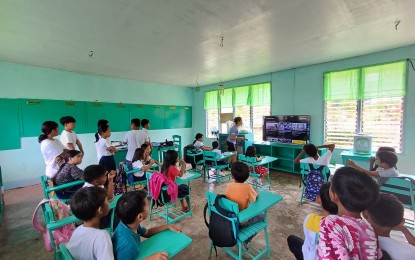
ONSITE LEARNING. Learners attend classes inside a classroom in Pintuyan, Southern Leyte in this undated photo. Schools in Southern Leyte and Biliran town in Biliran province temporarily resorted to alternative learning modes on Wednesday (April 3, 2024) due to extreme heat. (Photo courtesy of Buenaventura Elementary School)
TACLOBAN CITY – Schools in Southern Leyte and Biliran town in Biliran province temporarily resorted to alternative learning modes on Wednesday due to extreme heat, the Department of Education (DepEd) regional office here said.
Suspension of face-to-face classes has been implemented in Pintuyan Central School, Catbawan Elementary School (ES), Punod Primary School, Nueva Estrella ES, Son-ok ES, and Pintuyan National High School, all in Pintuyan town.
Other campuses are Abgao ES and Timba ES in Malitbog, Macrohon Central ES and Aguinaldo ES in Macrohon town, Buenavista ES in Bontoc, and Don Agustin F. Escano National High School in Tomas Oppus town.
“In the town of Biliran, Biliran, the local government issued an executive order on shifting to blended learning until April 19. The morning session is face-to-face, and the afternoon session is modular distance learning,” said DepEd Eastern Visayas regional information officer Jasmin Calzita.
The use of online or other distance learning modes seeks to minimize health and safety risks and uphold the physical and mental well-being of learners and school personnel.
The official said teachers are prepared to implement alternative delivery modes in the event of the suspension of classes due to extreme heat, heavy rains, typhoons, earthquakes, and other natural disasters.
The education department regularly disseminates heat index figures to guide school heads through its social media accounts.
Earlier, the Philippine Atmospheric, Geophysical, and Astronomical Services Administration warned of even warmer days ahead.
The weather bureau states that heat indices between 41 and 54 degrees Celsius are considered "dangerous" as they can lead to heat cramps and exhaustion, and with continued activity, a heat stroke is likely to occur.
Tacloban, the regional capital, recorded 41 degrees Celsius heat index on April 2. (PNA)
